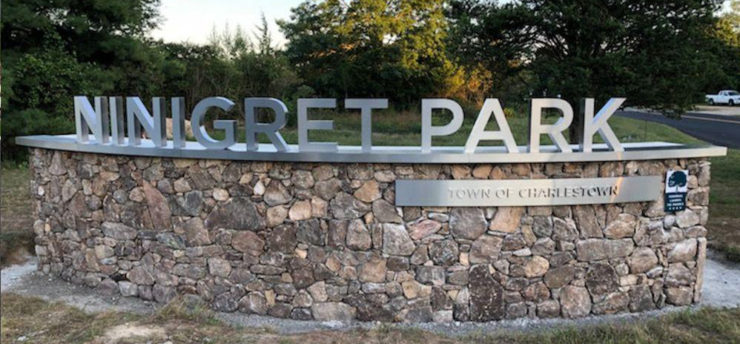Planning The Future Of Charlestown’s Ninigret Park
When: Monday, October 30 at 6 p.m.
Where: Charlestown Town Hall, 4540 South County Trail (Rt. 2)
What: Consultant will present three options for the Ninigret Park Master Plan
Planning for the future of Ninigret Park is well underway, and as part of the process, it is essential to understand how the Charlestown Naval Auxiliary Landing Field (CNALF) came to be Ninigret Park and the Ninigret National Wildlife Refuge.
The story begins in the early 1970s when CNALF was declared excess by the federal government. What followed was a long, intense fight by the citizens of Charlestown and others against the proposed sale of the property for a nuclear-power electrical generating plant.
Because it was the responsibility of US General Services to decide what would happen to CNALF, its acting administrator, Paul Goulding, took on the task after an environmental impact statement was filed in January 1979.
Goulding considered first the request of two other federal agencies: the US Fish and Wildlife Service (USFWS) and the Environmental Protection Agency (EPA). He then considered the unique ecological importance of the area for migrating birds and the extensive management network for wildlife in Charlestown. Finally, he took into account that, in a town referendum, a majority of Charlestown’s voters had voted against the nuclear plant.
He approved the transfer of 307 acres to the US Department of the Interior for a wildlife refuge and 60 acres to the EPA for research. He then selected Charlestown’s application, approving the transfer of the remaining 237 acres to Charlestown and ruling,“Such use is not to be inconsistent with the use of the other 367 acres transferred to the Department of Interior and the Environmental Protection Agency.”
Because the nuclear power plant was ruled out, Goulding’s decision was challenged in court. When the decision was upheld, the proposal to build a nuclear power plant in Charlestown was finally abandoned.
By resolution and in correspondence, the Charlestown Town Council affirmed its intention to use the 237 acres in a manner consistent with the Ninigret National Wildlife Refuge and advised that the transfer should go forward.
What the town acquired, though, was an abandoned military facility, an eyesore. Remaining on the property were over 30 derelict buildings, a large hanger, and miles of asphalt. The work began, governed by two Programs of Utilization, one in 1980 (updated in 1982) and the second dated 1994. Using ingenuity and with the help of the US National Guard, volunteers transformed the eyesore into our town park.
Throughout these years, the relationship between USFWS and the town was cooperative. For example, land was transferred to the town by USFWS so the criterion could use two runways. Permission was given to construct the athletic fields, in exchange for a buffer along the park boundary with the Ninigret National Wildlife Refuge.
Now, in 2023, citizens can plan the future of their park. Ideas and comments may be sent to the Parks and Recreation Commission subcommittee and the consultant in care of Vicky Hilton, Parks and Recreation Department Director, at vhilton@charlestownri.gov.
On October 30 at 6 pm at the Charlestown Town Hall, the consultant will present three options for the 2023 Master Plan.

Bonnie Van Slyke, the author of this post, was a member of the Charlestown Town Council from 2014 to 2022. She was the Town Council Liaison to the Planning Commission, Parks and Recreation Commission, and Senior Citizens Commission. She is a former officer and member of the Board of Directors of the Frosty Drew Observatory & Science Center, a former Chair of the Zoning Board of Appeals in Harvard, MA and a former member of the Board of Trustees of the Harvard Conservation Trust. Bonnie is a freelance copy editor, technical writer, and publications specialist. Bonnie writes occasionally about governance issues in Charlestown.

October 29, 2023 @ 5:12 pm
I am perplexed by the need for a new Master Plan discussion when the recent survey showed that the citizens of Charlestown like Ninigret Park the way it is and did not want it commercialized. Most citizens probably realized they’d be paying for infrastructure and enhancements that benefited developers more than them.
November 1, 2023 @ 7:29 am
Thank you Julie! I can’t agree more!!!
October 29, 2023 @ 1:05 pm
Leave Ninigret Park the hell alone!!
October 29, 2023 @ 12:18 pm
Agree with all above. Two more words: WILDLIFE REFUGE.
The urgency of protecting our environment and town is even more important now than it was in the 1970’s.
Noise pollution
Light pollution.
Migratory birds are in severe decline due to climate change, habitat loss, city lights, crashing into city buildings, do a little reading from the Audubon society mags and websites.
Nuff said, why do we have to keep doing this???
October 23, 2023 @ 3:47 pm
Please keep ninegret in its natural state. It is our precious resource
October 22, 2023 @ 1:33 pm
The decision granting the land for Ninigret Park to Charlestown says that the use of that land shall not be inconsistent with the use of the other land given to the USFWS. That land is preserved entirely in its natural state for wildlife and paths for people hiking. This clearly indicates that uses such as a large concert venue, and lighted ball fields are inconsistent with the use of the USFWS adjacent land.
The town wide survey also indicated that the Towns people wanted to use the Park as it is in its current state.
I urge all residents to write the the Town Rec dept to express their opinions, and I urge them to recommend that the park stay largely as it is now.
October 22, 2023 @ 12:06 pm
Thanks Bonnie and Mike for excellent descriptions of both how Charlestown became so fortunate as to get that land and to be able to develop it into what we now know as Ninigret Park, and the constraints on the uses of it.
I trust that the current planning process will take into account fully the results of the very recent town-wide survey relating to the majority of the citizens of Charlestown’s opinions and wishes on this topic.
Where can we find the MOU (Memorandum Of Understanding between the town and the federal government) on the permitted uses for Ninigret Park?
October 22, 2023 @ 4:48 am
I encourage everyone to read and discuss the MOU that we have with the USFWS. It is very specific about the relationship the town must have with that agency. Thus far, the two entities (USFWS and the Town) have coexisted within the priorities set down in the MOU. Also, the Town is obliged to file reports to the USFWS whenever changes to the MOU, signed last year, are being considered.